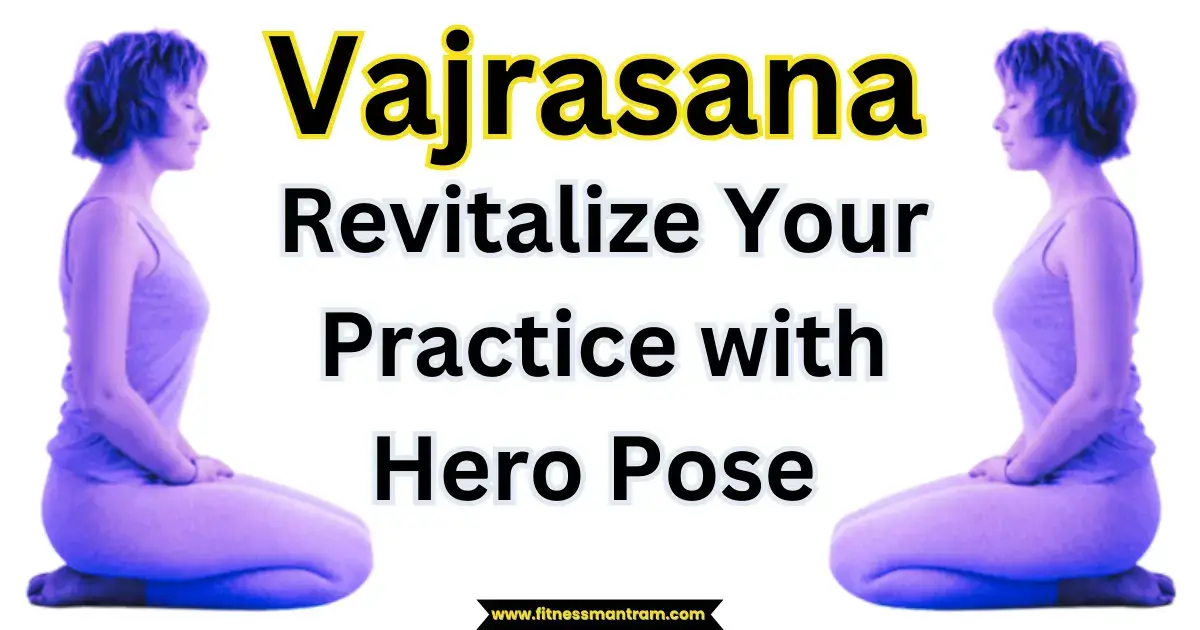If any individual who want to improve his yoga practice and wants to improve his physical and mental health? Then he should look towards Vajrasana (Virasana), which a powerful and transformative yoga pose. In this comprehensive guide, we will explore the origin, benefits, step-by-step instructions, variations, and precautions associated with Vajrasana. So, roll out your mat, find a quiet space, and let’s dive into the world of Vajrasana (Virasana)
Introduction to Vajrasana
Vajrasana, also known as the Hero Pose, is a seated asana that provides numerous benefits for the body and mind. It is originated from the Sanskrit word “Veera” which means warrior and “Asana” means pose. It shows the courage, strength and resilience of warrior. By practicing this asana, you can cultivate physical strength, mental focus, and emotional stability.
The Origin and Meaning of Vajrasana

This asana is ancient old yoga traditions and it is considered to have been practiced for centuries. The pose is named after the legendary warriors of Indian mythology and symbolizes their attributes of bravery, valor, and inner strength. This asana represents the warrior within each of us and encourages us to tap into our inherent power and courage.
Step-by-Step Guide to Perform Vajrasana
Preparing for Vajrasana
Before practicing this asana, it’s essential to create a suitable environment that promotes relaxation and focus. Take your yoga mat find a quiet and clean place where you can comfortably sit. Wear loose and comfortable clothing that allows for unrestricted movement.
Getting into the Starting Position
To begin practicing this asana start by kneeling on the floor with your knees hip-width apart. Keep your spine tall and straight, and gently tuck your tailbone under to engage your core. Place your hands on your thighs
Proper Alignment and Posture
In this asana, it’s crucial to maintain proper alignment and posture to maximize its benefits and prevent injury. Ensure that your spine remains elongated, with your shoulders relaxed and away from your ears. Engage your core muscles to support your lower back and maintain stability throughout the pose.
Breath Control in Vajrasana
As you settle into this asana, focus on your breath. Concentrate while taking your breaths, you need to take deep and slow breaths, while inhaling and exhaling can be done through your nose. By keeping your breath steady and smooth, you can feel a sense of calm and relaxation into your body and mind.
Maintaining the Pose
Hold this position for 30 seconds to 1 minute, or as long as feels comfortable for you. As you remain in the pose, continue to breathe deeply and mindfully. Feel the strength and stability radiating through your body, connecting with your inner warrior spirit.
Health Benefits of Vajrasana
This asana provides us with a wide range of health benefits . Let’s explore some of the significant advantages this pose provides:

- Strengthening the Legs and Core: This asana is an excellent way to strengthen the quadriceps, hamstrings, and calves of your legs. By holding the pose, you engage these muscles, promoting their development and increasing lower body strength. Additionally, this asana also activates the core muscles, contributing to better stability and balance.
- Improving Flexibility and Balance: Regular practice of this asana can enhance flexibility in the hips, knees, and ankles. It stretches the muscles and tissues in these areas, gradually improving their range of motion. Moreover, Veerasana helps improve balance by training your body to stay steady and centered.
- Enhancing Digestion and Elimination: This asana stimulates the digestive organs, including the stomach, intestines, and liver. Thus, due to increase of blow flow in digestive system can helps to overcome issues like indigestion and constipation. Incorporating this asana into your routine may promote a healthier digestive system.
- Relieving Stress and Anxiety: As a seated posture, this asana promotes relaxation and helps calm the mind. The deep breathing and focused attention required in this pose can reduce stress levels and alleviate anxiety. Regular practice of this asana can bring a sense of tranquility and inner peace, allowing you to manage stress more effectively.
- Boosting Confidence and Inner Strength: This asana symbolizes strength and courage, both physically and mentally. By practicing this pose, you can cultivate a sense of confidence and tap into your inner reservoirs of strength. This asana empowers you to face challenges with resilience and determination, both on and off the mat.
What are the Precautions and Contraindications Related to this Vajrasana
While this asana offers numerous benefits, it’s essential to practice it mindfully and with respect for your body’s limitations. You need to keep in mind the following given precautionary steps.
- If you have knee or ankle injuries, exercise caution when practicing this asana, Consider using props, such as blankets or bolsters, to support your joints and alleviate any discomfort.
- Individuals with high blood pressure should avoid deep forward bends in this asana. Instead, focus on maintaining a tall and elongated spine throughout the pose.
- If you have any existing medical conditions or concerns, it’s advisable to consult with a qualified yoga instructor or healthcare professional before attempting this asana
It is better not to go hard against your body limitations to perform this asana, slight modification can be done according your requirement in which your feel comfortable while performing this asana
Variations of Vajrasana
This asana offers various modifications and variations to accommodate different levels of practitioners. Here are a couple of variations you can explore
Modified Vajrasana for Beginners
If you’re new to this asana or have limited flexibility, you can modify the pose to make it more accessible. Instead of kneeling directly on the floor, sit on a folded blanket or a bolster to reduce strain on the knees and ankles. This modification allows you to gradually build strength and flexibility before attempting the full expression of this asana.
Advanced Vajrasana Variations
For those seeking a deeper challenge, there are advanced variations of this asana that intensify the pose. One such variation is Akarna Dhanurasana, where you reach back and hold onto the foot of the extended leg, deepening the stretch in the quadriceps and hip flexors. Another variation is Urdhva Dhanurasana, or Upward Bow Pose, which involves transitioning from this asana into a backbend, offering a profound opening in the chest and shoulders.
Remember to approach advanced variations with caution and under the guidance of an experienced yoga teacher to ensure proper alignment and avoid injury.
Incorporating Vajrasana into Your Yoga Practice
This asana can be practiced as a standalone pose or integrated into a sequence of yoga asanas. Consider including this asana in your warm-up routine to prepare the body for more intense postures or as part of your cool-down to promote relaxation and reflection. Its versatility allows you to explore creative ways of incorporating this asana into your personal yoga practice.
Tips for a Successful Vajrasana Practice
To make the most of your this asana practice, here are some valuable tips to keep in mind:
- Start with proper warm-up exercises to prepare your muscles and joints for the pose.
- Focus on maintaining a tall and upright spine throughout the pose, avoiding any rounding or slumping.
- Engage your core muscles to support your lower back and maintain stability.
- Breathe deeply and mindfully, allowing your breath to guide you deeper into the pose.
- Practice regularly and with patience, allowing your body to gradually progress in the pose.
- Listen to your body’s signals and modify the pose as needed to suit your individual needs and limitations.
- Seek guidance from a qualified yoga instructor to ensure proper alignment and technique.
By following these tips, you can optimize your Vajrasana practice and experience its full range of benefits.
Frequently Asked Questions
Can anyone practice Vajrasana?
Yes, Vajrasana is accessible to most individuals, but it’s important to listen to your body and modify the pose as needed.
How long should I hold the pose?
Initially starts slowly to remain in the pose for 30 to 60 seconds, once you become more comfortable and flexible with this position you can gradually increase the time period.
Can Vajrasana help with weight loss?
While Vajrasana can contribute to overall fitness and strength, it is not specifically targeted for weight loss. A well-rounded exercise routine and a balanced diet are key for weight management.
Is Vajrasana suitable during pregnancy?
Pregnant women should approach Vajrasana with caution. It’s advisable to consult with a prenatal yoga instructor or healthcare professional for modified poses that accommodate the changes in the body during pregnancy.
Can Vajrasana cure back pain?
Vajrasana can help strengthen the back muscles and improve posture, which may alleviate certain types of back pain. In case if you have back problem or other upper and lower back related issues you should first get in touch with your yoga instructor or health care professional before starting to practice this asana, get their personal advice and learn the proper technique how to perform and practice.
What should I do if I feel discomfort while practicing Vajrasana?
If you experience discomfort or pain during Vajrasana, ease out of the pose and modify it as needed. You can use props, such as blocks or bolsters, to support your body and make the pose more comfortable.
Can Vajrasana improve posture?
Yes, Vajrasana can contribute to better posture by strengthening the core muscles and promoting alignment of the spine. Regular practice can help develop an upright and balanced posture.
Are there any variations for people with knee pain?
If you have knee pain, it’s advisable to modify Vajrasana by placing a folded blanket or bolster under your knees for added support. This modification can help alleviate strain on the knees and make the pose more accessible.
Is Vajrasana beneficial for athletes?
Absolutely! Veerasana can be highly beneficial for athletes as it helps build leg strength, improve flexibility, and enhance balance. It also promotes mental focus and inner strength, which are valuable qualities for athletes.
Can Vajrasana help with menstrual discomfort?
Vajrasana can provide relief from menstrual discomfort by gently stretching the pelvic region and improving blood circulation in the abdominal area. The result may vary as each individual is different from one another. It is always advisable not to go hard against your body limitations to get better result if required you can make slight modification in this pose according to your need.
Conclusion
Vajrasana, the Hero Pose or Warrior Pose, is a powerful asana that embodies strength, courage, and resilience. To improve your flexibility, strengthen your body, cultivate balance and to enhance your mental health it is necessary to incorporate this asana in to your daily routine of yoga practice. Remember to approach Vajrasana (Veerasana) with mindfulness, honouring your body’s limitations and modifying the pose as needed. With regular practice and dedication, Vajrasana can empower you to embody the warrior within and embrace your innate strength and vitality.
Begin your journey with Vajrasana (Veerasana) today and experience the transformative benefits it has to offer!
You May Also Like

2 thoughts on “Vajrasana- Ultimate Guide to this Ancient Yoga Pose”